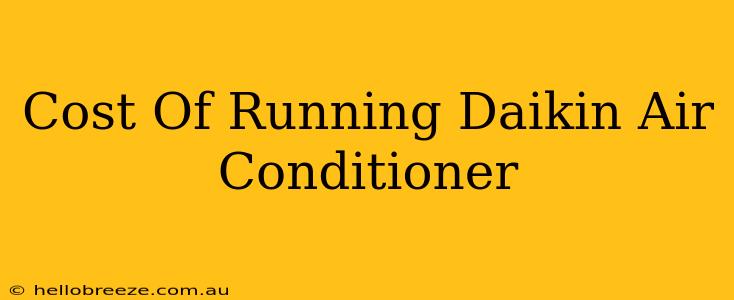Choosing the right air conditioner can be a significant investment, but understanding the ongoing running costs is just as crucial. This guide dives deep into the factors influencing the cost of running a Daikin air conditioner, helping you make an informed decision.
Understanding Your Daikin's Energy Consumption
Daikin is known for its energy-efficient models, but the actual cost depends on several key factors:
-
Model and SEER Rating: The Seasonal Energy Efficiency Ratio (SEER) is a crucial indicator of efficiency. Higher SEER ratings (generally 15 or above for newer Daikin models) mean lower energy consumption and, consequently, lower running costs. Check your specific Daikin model's SEER rating in the product specifications.
-
Air Conditioner Size: An air conditioner that's too small will work harder, consuming more energy. Conversely, one that's too large might cycle on and off frequently, also reducing efficiency. Proper sizing by a qualified HVAC professional is vital.
-
Usage: The more you use your Daikin air conditioner, the higher the electricity bill. Factors like climate, house insulation, and personal preferences all impact usage.
-
Electricity Prices: Your local electricity rates directly influence the cost. Higher rates mean higher running costs.
Calculating Your Daikin Air Conditioner Running Costs
Estimating the precise cost requires some calculations. Here's a simplified approach:
-
Find your Daikin's power consumption: This information (usually measured in watts or kilowatts) is in the owner's manual or on the unit itself.
-
Convert to kilowatt-hours (kWh): Divide the wattage by 1000.
-
Estimate daily usage: This depends on your usage patterns. Let's say you run your AC for 8 hours daily.
-
Calculate daily energy consumption: Multiply the kWh value (from step 2) by your daily usage hours (from step 3).
-
Calculate monthly energy consumption: Multiply your daily energy consumption (from step 4) by 30 (or the number of days in your billing cycle).
-
Determine the cost: Multiply your monthly energy consumption (from step 5) by your electricity price per kWh.
Example:
Let's assume your Daikin uses 1000 watts (1 kW), runs for 8 hours daily, and your electricity costs $0.15 per kWh.
- Daily energy consumption: 1 kW * 8 hours = 8 kWh
- Monthly energy consumption: 8 kWh * 30 days = 240 kWh
- Monthly cost: 240 kWh * $0.15/kWh = $36
This is a simplified calculation. Actual costs can vary.
Tips to Reduce Your Daikin Air Conditioner Running Costs
-
Regular Maintenance: Scheduling annual maintenance ensures optimal performance and energy efficiency. This includes cleaning or replacing filters, checking refrigerant levels, and inspecting components. A well-maintained Daikin will operate at peak efficiency.
-
Improve Home Insulation: Better insulation reduces the load on your air conditioner, resulting in lower energy consumption. Consider sealing air leaks and adding insulation to walls and attics.
-
Utilize Smart Features: Many Daikin models offer smart features allowing you to control the unit remotely and schedule operation, optimizing energy use.
-
Strategic Use of Fans: Combining your Daikin with ceiling fans can significantly reduce the need for intense cooling.
-
Consider a Daikin Inverter Model: Inverter technology offers more precise temperature control and reduces energy waste compared to older on/off models.
Choosing the Right Daikin Air Conditioner for Your Needs
Before purchasing a Daikin air conditioner, consult with an HVAC professional to determine the appropriate size and model for your home. They can help you choose a unit that balances performance and energy efficiency to minimize running costs while providing comfortable cooling. Investing in a high-efficiency model upfront might seem pricier, but the long-term savings on energy bills can make it a worthwhile investment.
By understanding the factors influencing running costs and implementing energy-saving strategies, you can effectively manage the cost of running your Daikin air conditioner and enjoy cool comfort without breaking the bank.

